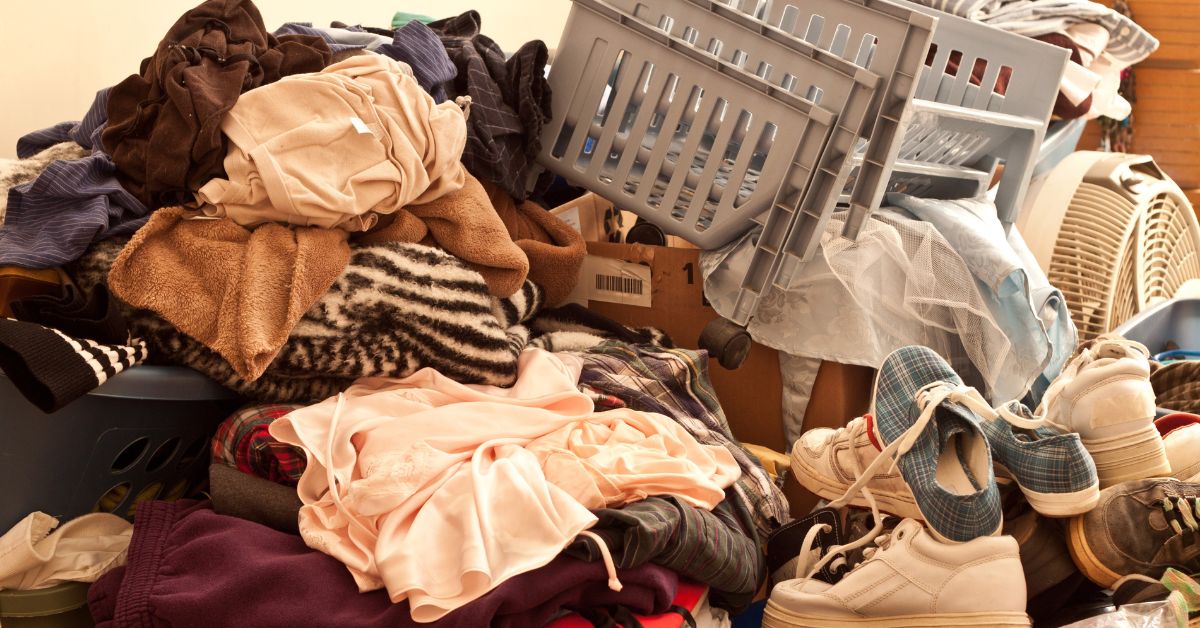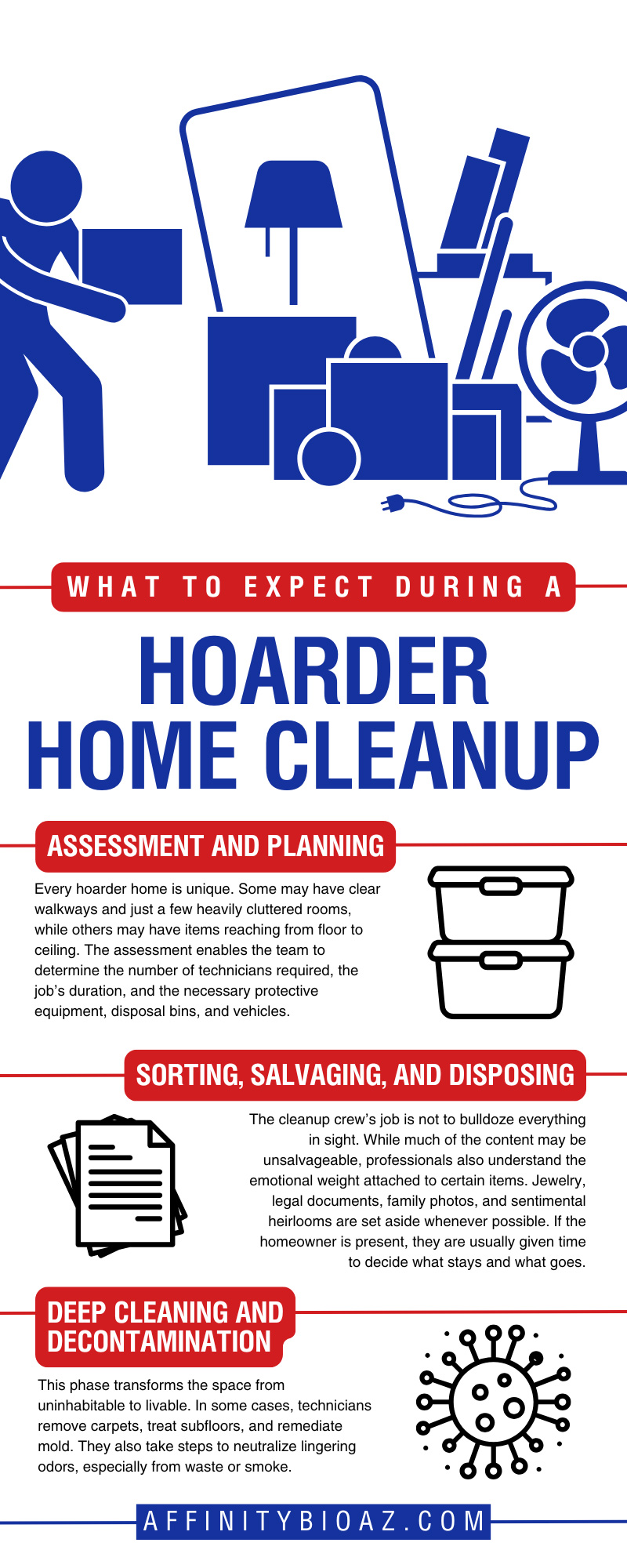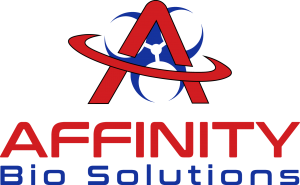
Cleaning a hoarder home involves more than trash bags and mops. It’s an emotional, physical, and logistical journey that requires sensitivity and a well-prepared plan. Whether you’re helping a loved one reclaim their space or managing a property after a crisis, what to expect during a hoarder home cleanup isn’t always clear. At Affinity Bio Solutions, we understand how stressful the process can be, and we’re here to help guide you through the process.
In this blog, we’ll walk through what the cleanup process actually looks like from the first phone call to the final walkthrough. Understanding what happens can help you alleviate anxiety and set realistic expectations.
Emotional Considerations and Family Dynamics
Hoarding is a mental health condition, not a lifestyle choice. Many families bring in professional help because prior attempts to clean have led to emotional distress, conflict, or even estrangement. That’s why trauma-informed care is so critical.
A reputable cleanup crew treats the people involved with dignity and respect. If the person who hoarded the items is present during the cleanup, technicians may pause periodically to offer reassurance or allow the person time to process their emotions. In some cases, family members or mental health professionals stay on-site during the cleanup to provide additional support.
Being prepared for emotional reactions is key. Cleaning out a hoarder home often triggers grief, guilt, anxiety, and even anger. You may uncover lost personal belongings or face the heartbreaking reality of ruined possessions.
If you ever feel overwhelmed during the process, know this: reputable companies that clean hoarder homes don’t judge. At Affinity Bio Solutions, we come to help, and we know exactly what it takes to do the job right.
Biohazards and Safety Risks
One of the most critical reasons to hire professionals is the risk of exposure to hazardous materials. Many hoarder homes contain:
- Mold spores from long-term moisture damage
- Rodent and insect infestations
- Human waste or pet feces
- Expired food and medicine
- Needles or broken glass
- Structural instability from rotting floors or heavy clutter
Never attempt to clean a hoarder home without the proper safety equipment. The unseen dangers are often worse than the visible clutter. Professionals wear full-body protective suits, gloves, boots, and respirators to protect themselves from hazards.
Assessment and Planning
Before anyone starts moving items or hauling trash, the process begins with an on-site assessment. During this phase, a technician or project manager visits the property to evaluate the scope of the cleanup. This includes:
- The number of rooms affected
- The volume and type of contents (e.g., household goods, perishables, hazardous materials)
- Accessibility and structural safety
- Pest infestations, mold, or biohazards
- Odors and ventilation needs
Every hoarder home is unique. Some may have clear walkways and just a few heavily cluttered rooms, while others may have items reaching from floor to ceiling. The assessment enables the team to determine the number of technicians required, the job’s duration, and the necessary protective equipment, disposal bins, and vehicles.
Expect honesty during this phase. A good company won’t sugarcoat the process—they’ll give you a realistic timeline and outline any challenges that could arise.
Sorting, Salvaging, and Disposing
The cleanup crew’s job is not to bulldoze everything in sight. While much of the content may be unsalvageable, professionals also understand the emotional weight attached to certain items. Jewelry, legal documents, family photos, and sentimental heirlooms are set aside whenever possible. If the homeowner is present, they are usually given time to decide what stays and what goes.
Here’s how the sorting process often works:
- Anything clearly damaged by mold, insects, water, or waste goes into disposal bins.
- Items in usable condition may be donated with the homeowner’s consent.
- The team boxes and stores any safe personal belongings that the owner wishes to keep in a designated area.
- Licensed disposal teams handle biohazards and chemicals.
The team works room by room, methodically clearing pathways and documenting the process as needed for property managers or family members.
Deep Cleaning and Decontamination
Once the clutter is gone, the real cleaning begins. This step involves deep-cleaning surfaces, walls, flooring, and appliances. Depending on the level of contamination, technicians may use:
- Industrial vacuums with HEPA filters
- Antimicrobial and deodorizing agents
- Steam cleaners or foggers
- Air scrubbers and ozone machines
This phase transforms the space from uninhabitable to livable. In some cases, technicians remove carpets, treat subfloors, and remediate mold. They also take steps to neutralize lingering odors, especially from waste or smoke.
By the end of this stage, the home feels drastically different in appearance, air quality, and safety.
Final Walkthrough and Support
After the cleanup and deep decontamination are complete, the team conducts a final walkthrough with the homeowner or responsible party. This stage is essential for reviewing the work and addressing any lingering concerns.
Walkthrough
During the walkthrough, the lead technician explains what actions the team took in each area of the home, answers questions, and provides guidance on any areas that may need future attention. It’s also an opportunity for the homeowner to see the transformation in full and begin reconnecting with the space.
Depending on the condition of the home and the client’s goals, additional services may be discussed at this point. Some properties require pest control to prevent recurring infestations. Others may benefit from junk hauling services to clear out garages, sheds, or exterior spaces. In homes that have experienced structural damage or extensive contamination, minor repairs or remodeling may be necessary to restore full functionality and safety.
Documentation
Documentation is also part of the final stage. Most professional cleanup companies provide before-and-after photos, a detailed invoice, and proof of proper disposal for any biohazardous or hazardous materials. This information can be valuable for property managers or anyone working with insurance or housing authorities.
A Fresh Start Is Possible
Whether you’re tackling a small clutter issue or a full property, knowing what to expect during a hoarder home cleanup can help you make informed decisions and reduce emotional strain. From assessment and planning to sorting, cleaning, and aftercare, each step brings the home closer to safe, healthy living.
At Affinity Bio Solutions AZ, we treat every client with compassion and every home with respect. We don’t just clean; we help people take their first steps toward healing. And we’re ready to help you, too.

